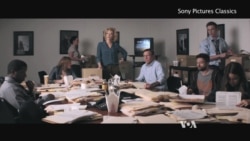In 2004, just months before George W. Bush was re-elected president, the television network CBS released a news report suggesting he shirked his military service during the 1970s. The documents that underpinned the story soon were found to be likely forgeries, and the fallout cost a number of high-level news reporters and producers their jobs.
The film Truth tells the tale of the events surrounding this career-ending reporting debacle. A cautionary tale about journalists' first obligation — to get the facts straight — it also highlights the very real risks, and responsibilities, involved in news production.
In September 2004, the campaign season was in full swing, with Bush holding a slight lead over John Kerry, and the election just two months away.
CBS producer Mary Mapes, who broke the Abu Ghraib story during a 60 Minutes segment, had uncovered evidence that second term-seeking President George W. Bush used his family and political connections to avoid the Vietnam War by enlisting in the National Guard, and then disappeared altogether from the Guard in the 1970s.
Mapes and Dan Rather, the venerable anchor of 60 Minutes, assembled an investigative team to research the story and validate documents they had received from Bill Burkett, a former Texas Army National lieutenant colonel. These documents were the foundation, the 'smoking gun,' that proved and underpinned the entire story.
Called the Killian documents, they carried the signature of the then deceased Lt. Col. Jerry B. Killian, commanding officer of the 111th Fighter Intercept Squadron during President Bush’s service. More documents surfaced supporting the Killian documents. However, there was a hitch: The documents were copies of the originals and the originals were allegedly destroyed. But Burkett vouched for their authenticity, and signature experts ruled that the signatures did belong to Lt. Col. Killian, so the CBS team felt they had an airtight case.
The story aired on September 8, 2004.
As early as the next day, conservative bloggers claimed the documents were fake, mere computer recreations, and not copies of 1970s typewritten material. They denounced the 60 Minutes report as liberal propaganda, an attempt to hurt Bush’s re-election bid.
CBS executives asked Mapes' team to interview its sources on camera regarding the validity of the documents. Bill Burkett then came forward and changed his story, saying he received the document copies from people he did not know. Unable to corroborate where the material came from, Rather was forced to step down as CBS anchor, and Mapes faced an internal inquiry on her motives in airing the story.
The film — based on Mapes’ memoir Truth and Duty: The Press, the President and the Privilege of Power — offers a sympathetic look at the feisty CBS producer, who bears the brunt of the responsibility for the report. The film suggests she was abandoned by network executives trying to protect themselves in a politically-charged environment.
The film is helped by a thought-provoking and meticulously written script. Robert Redford interprets a poised Dan Rather and Cate Blanchett offers an Oscar-worthy performance as the embattled producer.
Filmmaker and writer James Vanderbilt builds the story’s tragic momentum in a measured and balanced pace, giving viewers a step-by-step deconstruction of a news story in which the truth was lost in the details.









